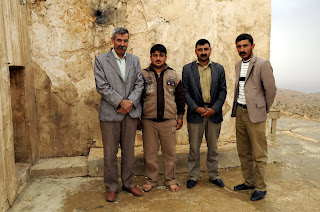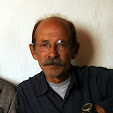24 October 2012 - The Yezidi temple of Sheikh Chilmira is
surrounded by razor wire and soaked in clouds, the former from the
hastily constructed American military base now manned by four Iraqi
Army soldiers; the latter because we are on the crest of Sinjar
Mountain in western Iraq. As Sheikh Gharbi, brother Bobir, son
Faisel, and I approach, thin, matted-hair dogs bark our arrival. A
soldier named Daud, a Yezidi himself, warmly welcomes us. Visitors
and pilgrams are few these days.
Daud leads us to the passage through
the razor wire; intermittent winds lead us to the temple's east side
where we join hundreds of fingernail-sized black beetles plastered on
the walls, they too seeking refuge from the west wind. The clouds briefly part and we gather at the edge of the crest looking to the north. Five hundred meters below and 15 kilometers distant the sun is shining on Sherif al Din, perhaps the most well-known temple in the Sinjar, where we will visit later in the day.
We enter the open courtyard, and taking off our shoes, stoop to pass through the Hobbit-sized arched passage to the inner chamber, taking care not step on the threshold. Gharbi and the others kiss the stone wall before entering. The windowless room is small, but domed ceiling high.
We enter the open courtyard, and taking off our shoes, stoop to pass through the Hobbit-sized arched passage to the inner chamber, taking care not step on the threshold. Gharbi and the others kiss the stone wall before entering. The windowless room is small, but domed ceiling high.
After our eyes adjust to the darkness we see a few swaths of brightly colored silk
hanging on the walls, damp and languid. As tradition holds, we tie and untie knots to
make our wishes and to release those of others before. In the floor there
is a hole, just large enough for an arm. Gharbi kneels and reaches
down to his shoulder bringing up some soil in his fingertips. He
dabs some on his forehead – to cure illness he says. Feeling a
the beginnings of a cold, I do the same while thinking about the holy dirt at
the Catholic Sanctuario de Chimayo in northern New Mexico.
The Yezidis do not have a monopoly on such practices.
It starts to rain. Large drops. We hastily say our goodbyes over Daud's repeated invitations to stay for tea, and race back to the truck picking our way through the concrete barriers and razor wire, a chorus of barking cheering our every step.
As we drive off of the mountain crest, a covey of partridge flush from the roadside. “This is a symbol,” says Gharbi smiling. "Today will be a good day." And so it was.









No comments:
Post a Comment